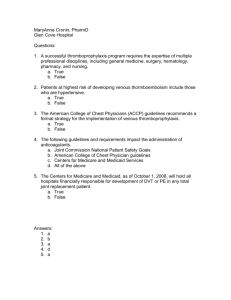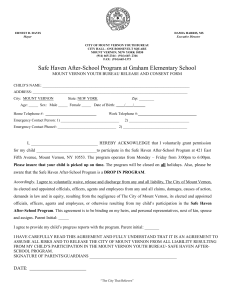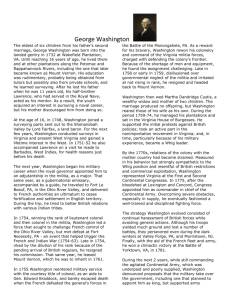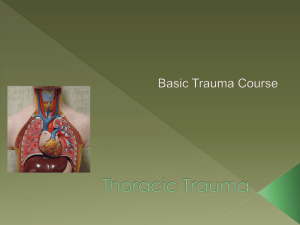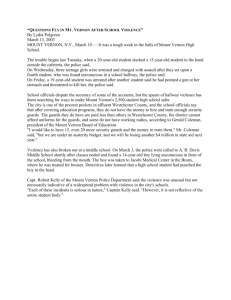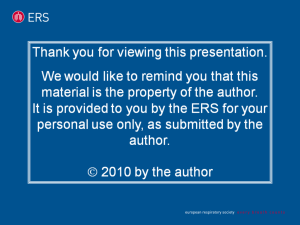INOVA MOUNT VERNON HOSPITAL
advertisement
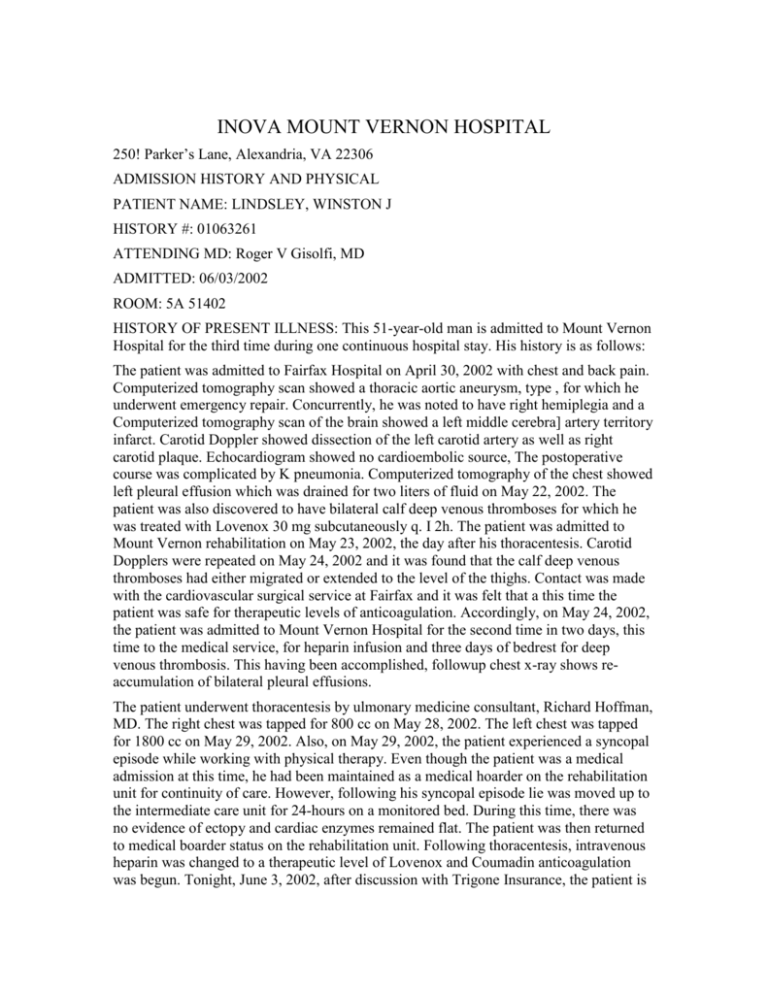
INOVA MOUNT VERNON HOSPITAL 250! Parker’s Lane, Alexandria, VA 22306 ADMISSION HISTORY AND PHYSICAL PATIENT NAME: LINDSLEY, WINSTON J HISTORY #: 01063261 ATTENDING MD: Roger V Gisolfi, MD ADMITTED: 06/03/2002 ROOM: 5A 51402 HISTORY OF PRESENT ILLNESS: This 51-year-old man is admitted to Mount Vernon Hospital for the third time during one continuous hospital stay. His history is as follows: The patient was admitted to Fairfax Hospital on April 30, 2002 with chest and back pain. Computerized tomography scan showed a thoracic aortic aneurysm, type , for which he underwent emergency repair. Concurrently, he was noted to have right hemiplegia and a Computerized tomography scan of the brain showed a left middle cerebra] artery territory infarct. Carotid Doppler showed dissection of the left carotid artery as well as right carotid plaque. Echocardiogram showed no cardioembolic source, The postoperative course was complicated by K pneumonia. Computerized tomography of the chest showed left pleural effusion which was drained for two liters of fluid on May 22, 2002. The patient was also discovered to have bilateral calf deep venous thromboses for which he was treated with Lovenox 30 mg subcutaneously q. I 2h. The patient was admitted to Mount Vernon rehabilitation on May 23, 2002, the day after his thoracentesis. Carotid Dopplers were repeated on May 24, 2002 and it was found that the calf deep venous thromboses had either migrated or extended to the level of the thighs. Contact was made with the cardiovascular surgical service at Fairfax and it was felt that a this time the patient was safe for therapeutic levels of anticoagulation. Accordingly, on May 24, 2002, the patient was admitted to Mount Vernon Hospital for the second time in two days, this time to the medical service, for heparin infusion and three days of bedrest for deep venous thrombosis. This having been accomplished, followup chest x-ray shows reaccumulation of bilateral pleural effusions. The patient underwent thoracentesis by ulmonary medicine consultant, Richard Hoffman, MD. The right chest was tapped for 800 cc on May 28, 2002. The left chest was tapped for 1800 cc on May 29, 2002. Also, on May 29, 2002, the patient experienced a syncopal episode while working with physical therapy. Even though the patient was a medical admission at this time, he had been maintained as a medical hoarder on the rehabilitation unit for continuity of care. However, following his syncopal episode lie was moved up to the intermediate care unit for 24-hours on a monitored bed. During this time, there was no evidence of ectopy and cardiac enzymes remained flat. The patient was then returned to medical boarder status on the rehabilitation unit. Following thoracentesis, intravenous heparin was changed to a therapeutic level of Lovenox and Coumadin anticoagulation was begun. Tonight, June 3, 2002, after discussion with Trigone Insurance, the patient is being discharged from the medical service and readmitted to the rehabilitation service without change in his hospital bed. MEDICATIONS: The patient’s medications at the time of readmission to rehabilitation consist of Catapres patch TTS-3 weekly, Norvasc 10 mg q.a.m., Prevacid 30 mg q.a.m., Lasix 40 mg q.a.m., INOVA MOUNT VERNON HOSPITAL 2501 Parker’s Lane, Alexandria, VA 22306 DISCHARGE SUMMARY PATIENT NAME: LINDSLEY, WINSTON J HISTORY #: 0 Page 2 of2 The patient’s medications at the time of rehabilitation discharge consisted of Catapres TTS-3 patch, Norvasc 10 mg q.am., Prevacid 30 mg qam., Lasix 40mg q.a.m., potassium chloride 20 mEq qam., abetalol 400 mg q8h. and heparin infusion per deep venous thrombosis protocol. Roger V Gisolfi, MD 005/24/2002 4;43P;T05/28/2002 I0:48A;875-- 1010146,000110146,It4Sl CC: Roger V Gisolfi, MD INOVA MOUNT VERNON HOSPITAL 2501 Parker’s Lane, Alexandria, VA 22306 DISCHARGE SUMMARY PATIENT NAME: LINDSLEY, WINSTON J HISTORY #: 01063261 ATTEND MD; Roger V Gisolfi, MD ADMITTED: 05/23/2002 DISCHARGED: 05/24/2002 LIST OF DIAGNOSES: Cerebrovascular accident - Left middle cerebral artery territory infarct. 2. Right hemiparesis. 3. Global aphasia. 4. Apraxia. 5. Dissection of left internal carotid artery. 6, Thoracic aortic aneurysm, type 1, status post repair April 30, 2002. 7. Klebsie!la pneumonia. 8. Bilateral pleural effusions. 9. Dysphagia. 10. Bilateral lower extremity deep venous thrombosis. NARRATIVE SUMMARY: This SI-year-old man was admitted to Fairfax Hospital on April 30, 2002 with chest and back pain. Computerized tomography scan showed a thoracic aortic aneurysm, type 1, and the patient underwent an emergency repair. The patient was concurrently noted to be right hemiplegic. Computerized tomography scan of the brain showed a left middle cerebral territory infarct. Carotid Doppler study showed a dissection of the left carotid artery as well as right carotid plaque. Echocardiogram showed no cardioembolic source. The patient’s postoperative course was complicated by Klebs pneumonia. Computerized tomography scan of the chest showed a loculated left pleural effusion; this was drained of two liters of fluid on May 22, 2002. The patient was also found to have bilateral calf deep venous thromboses which was medicated with Lovenox 30 mg subcutaneously q.12h. On May 23, 2002, the patient was admitted to Mount Vernon rehabilitation. PHYSICAL EXAMINATION: The physical examination at the time of admission to Mount Vernon rehabilitation showed a nonverbal, alert gentleman and history was therefore unobtainable from the patient. He had a right hemiparesis with a strength of grade 3/5. He was expressively and receptively aphasic. He was also noted to be apraxic. A nasogastric tube was in place for feeding purposes. HOSPITAL COURSE: On the morning following admission, foilowup bilateral lower extremity venous Dopplers were obtained and showed that the calf deep venous thrombosis had migrated into the thigh. Contact was made with the cardiovascular surgical service at Fairfax Hospital and I was advised that the patient was safe for therapeutic levels of anticoagulation. Accordingly, the patient was begun on intravenous heparin drip and placed at bedrest. He is, accordingly, on May 24, 2002 discharged from the rehabilitation service and admitted to the internal medicine service of Dr. Gisolfi. INOVA MOUNT VERNON HOSPITAL 2501 Parker’s Lane, Alexandria, VA 22306 ADMISSION HISTORY AND PHYSICAL PAT NAME: LINDSLEY, WINSTON HISTORY #: 01063261 Page 2 of 2 potassium chloride 20 mEq q.a.m., Peri-Colace one capsule h.s., Colace IO mg bid., Ambien 10 mg h.s., labetalol 500 mg q.8h., Lovenox 100 mg q.12h. subcutaneously, Coumadin 6 mg qp.m., Lactulose p.rn. constipation, Dulcolax suppository prn. constipation, Fleets enema p.rn. constipation and Catapres 0.1 mg p.o. g.óh. p.r.n. for systolic blood pressure greater than 150 or diastolic blood pressure greater than 90. ALLERGIES: The patient has no known drug allergies. PAST MEDICAL HISTORY: The patient is a known hypertensive. PHYSICAL EXAMINATION: Physical examination at the time of readmission to rehabilitation shows an alert, globally aphasic gentleman. He has a right hemiparesis but has antigravity strength. His pulmonary status is stable at this time. Pulse oximetiy is 93% on room air. Roger V Gisolfi, MD D 06103/2002 6: P; T 06/05/2002 2:52 P; 875-- 1025344 000125344, #456373 CC: Roger V Gisolfi, M INOVA MOUNT VERNON HOSPITAL 2501 PARKERS LANE, ALEXANDRIA, VA 22306 (703)664-7171 RADIOLOGY REPORT PATIENT NAME: LINDSLEY, WINSTON MED REC #: 1063261 D. 0.8.: 05/31/1950 REQUEST if: 90015 ORD. DR.: HOFFMAN, RICHARD DATE OF EXAM: 06/11/2002 03:O9PM ATN. DR.: GISOLFI, ROGER NS/BED: 5A 514 MS 14-02 Page I oil EXAMINATION: -CHEST2 VIEWS REASON FOR EXAM: CONGESTION FOLLOW UP PLEURAL EFFUSION INTERPRETA TION: DATE: 06/11/02. PROCEDURE: CHEST. INDICATION: 52 year old male with chest congestion. TECHNIQUE: Two views. FINDINGS: Since 06/03/02, the left pleural effusion has decreased, but there is now an area of atelectasis at the left base. The exam is otherwise unchanged. Again, the heart is large, the soda ectatic, and there is evidence of previous sternotorny. The right lung remains clear. Surgical clips overlie the right upper chest. IMPRESSION: IMPROVED LEFT PLEURAL EFFUSION WITH NEW LEFT BASILAR ATELECTASIS. OTHERWISE NO CHANGE SINCE 06/03/02. READING OR: CALVIN NEITHAMER ELECTRON/CALL V SIGNED BY: CALVIN NEITHAMER MD HMG - 06/12/2002 06:4 7 INOVA MOUWT VERNON HOSP(TAL 2501 PARKERS LANE, ALEXANDRIA, VA 22305 (703)664-7171 RADIOLOGY REPORT PATIENT NAME: LINDSLEY, WINSTON MED REC #: 1063261 D.O.B.: 05/31/1950 REQUEST #: 90014 ORD. DR.: GISOLFI, ROGER DATE OF EXAM: 06/03/2002 O8:39AM ATN. DR.: GISOLFI, ROGER NS/BED: 5A 574 M5 Page 1 of I EXAMINATION: -CHEST 2 VIEWS REASON FOR EXAM: SOB INTERPRETATION: EXAM: CHEST. HISTORY: Shortness of breath. FINDINGS: Two films were obtained. The head is enlarged. There is a reaction present at the lung bases particul8rly on the left consistent with a left pleural effusion. Surgical clips are seen over the right upper thorax. Sternotomy sutures are present. Compared with the study of 05/31 there has been some improvement in the previously described vascular congestive changes. READING DA: JOHN DE GRAZIA ELECTRONICALLY SIGNED By: JOHN Off GRAZIA MD HMG - 06/03/2002 16:58
